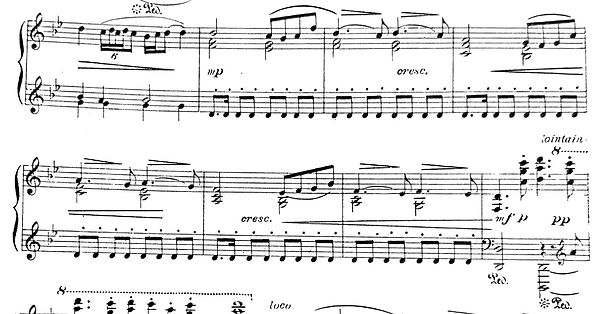
-
"Ménétriers et glaneuses"
"Ménétriers et glaneuses" refers to the protagonists of their pilgrimage to Font-Romeu, in the French Cerdanya. The party, of a religious nature, lasts all day. It is an open-air festival, around the "Ermitage" of Font-Romeu that houses the Virgin Mary, where it remains from the summer solstice until the first Sunday closest to September 8, when it is transported in procession to the nearby town of Odeilló. In this number I combine what I have heard and recorded in the procession of September 11, 2022 with what Séverac captured, which was obviously very different, starting with the speaker...
Séverac makes specific mention in the title of the musicians, which means that it evokes and transports him directly to an experience starring these ménétriers[i]. For me they are very present with the imitation of the vibrato of the Catalan instruments and the accompaniment of the tambourine in a festive atmosphere. It makes me think that music had greater weight back then in this party than it has today. The glaneuses are the gleaners, the women who gather the ears of corn after the harvest and entrust themselves to the Virgin praying for a good harvest in the middle section.
My proposal begins with the sound of people talking in French and the noise in the background before the procession begins, in this case, before hearing the two initial powerful octaves in ff of Séverac imitating the metal wind instruments of the cobla. It is followed by the two introductory measures, in which we hear the characteristic vibrato of Catalan instruments that will continue during this part of the piece (Ex. 9).

Ejemplo 9. “Ménétriers et glaneuses”, cc. 1-2. Fuente: Séverac, Déodat de. Cerdaña: etudes pittoresques pour Piano. París: Rouart-Lerolle & cie, 1919, 32.
It is obvious that with the “D'après le thème d'une “SERDAÑA” (danse populaire en Cerdagne et en Catalogne)” that Séverac writes for the first theme, that it is a rereading of a Catalan theme, which could well have been heard on the pilgrimage to Font-Romeu. The melody of the sardana theme, that would be perfect for the flugelhorn, contains the features of these dances: lowered 6th, dotted rhythm, seconds and ornaments, and the fourths and fifths as a common sonority of the cobla (Ex. 10 and min. 0:10).

Ejemplo 10. “Ménétriers et glaneuses”, cc. 3-6.Fuente: Séverac, Déodat de. Cerdaña: etudes pittoresques pour Piano. París: Rouart-Lerolle & cie, 1919, 32.
Very soon starts a new them where the texture is less dense and the different sound levels are clearer, with like a quartet instrumentation that could perfectly also be for the cobla (min. 0:24). In the background we hear the recording of people talking again, but with the addition of the bells of the Marian sanctuary. The bells are incorporated because the time of the procession is approaching (Ex. 11).

Ejemplo 11. “Ménétriers et glaneuses”, cc. 9-12.Fuente: Séverac, Déodat de. Cerdaña: etudes pittoresques pour Piano. París: Rouart-Lerolle & cie, 1919, 33.
Later the transition towards prayer begins to be heard with my performance (min. 1:00). Therefore, we begin to hear people talking and the bells ringing again in the recording, but this time you can hear the priest with the loudspeaker calling the attention of the pilgrims for the start of the procession.
Right after his phrase, the prayer begins, recited by a child in the recording because in Séverac the theme is also very high (Ex. 12 and min. 1:12). The prayer continues on the piano and after the rest of the sixth measure I introduce a replica of the priest praying. Séverac evokes meditation in contrast to celebration, as Robert Francis Waters in his thesis “Regionalism and Catalan Folk Elements in the Compositions of Déodat de Séverac” says: “Séverac depicts the ancient custom of uniting dance with Catalan religious tradition” (Waters 2002, 215), a very accurate reflection, considering that this pilgrimage consists of celebration and prayer even today. In this part we hear the goigs, a typically Catalan hymn to the Virgin Mary with introduction followed by couplets and refrain.

Ejemplo 12. “Ménétriers et glaneuses”, cc. 29-31.Fuente: Séverac, Déodat de. Cerdaña: etudes pittoresques pour Piano. París: Rouart-Lerolle & cie, 1919, 35.
After a moment of maximum tension in ff, octaves and chords, we hear the priest with the people singing (min. 2:39). Later starts a section of the sardana with the repeated notes in the left hand that represent the tambourine, as Fábregas points out (Ex. 13): “The repeated note in the left hand represents the tamboret played by the same musician playing the flaviol in the cobla” (Ex. 13 and min. 3:22) [ii].

Ejemplo 13. “Ménétriers et glaneuses”, cc. 76-83.Fuente: Séverac, Déodat de. Cerdaña: etudes pittoresques pour Piano. París: Rouart-Lerolle & cie, 1919, 38.
And finally, just before begins the memory or nostalgia for Albéniz, in the audio the goig in Catalan is heard (Ej. 14 and min. 4:29), which is part of the current repertoire that is sung in the procession, as a nod to this composer, but also to the double feeling of belonging and to the two languages and cultures that coexist in this region, Catalan and French.

Ejemplo 14. “Ménétriers et glaneuses”, cc. 102-103.Fuente: Séverac, Déodat de. Cerdaña: etudes pittoresques pour Piano. París: Rouart-Lerolle & cie, 1919, 40.
[i] In the Catalunya Nord region ménétriers are still called jutglars today.
[ii] “The repeated note in the left hand represents the tamboret played by the same musician playing the flaviol in the cobla” (Fàbregas i Marcet 2002, 42).

[i] In the Catalunya Nord region ménétriers are still called jutglars today.
[ii] “The repeated note in the left hand represents the tamboret played by the same musician playing the flaviol in the cobla” (Fàbregas i Marcet 2002, 42).












